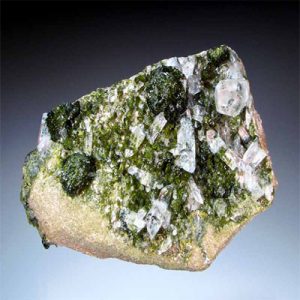Pumpellyite
Chlorastrolite, also known as Greenstone or Green Starstone, is a rare variety of Pumpellyite-(Mg) that was first discovered at Isle Royale, Lake Superior, Michigan, USA by C. T. Jackson and J. D. Whitney in 1847. The chemical formula of Chlorastrolite is Ca2MgAl2(SiO4)(Si2O7)(OH)2 • (H2O) (Hydrated Calcium Magnesium Silicate Hydroxide) and its molecular weight is 470.70 gm.
Chlorastrolite was once thought to be an impure variety of Prehnite or Thomsonite. Chlorastrolite has a specific gravity of 3.2 and the refractive index of 1.674 – 1.722 Biaxial ( + ) and ( – ). Beautiful dark green Chlorastrolie cabochons exhibit chatoyancy in a distinctive mosaic or segmented pattern sometimes referred to as “turtleback” due to its similarity to the pattern on a turtle shell. The colors of Chlorastrolite resemble fine Emerald or Imperial Jade. Chlorastrolite is the state gemstone of Michigan.
| Category: | Sorosilicate |
| Chemical Formula: | Ca2MgAl2(SiO4)(Si2O7)(OH)2 • (H2O) |
| Hydrated Calcium Magnesium Silicate Hydroxide | |
| Molecular Weight: | 470.70 gm |
| Composition: | Calcium | 17.03 % | Ca | 23.83 % | CaO |
| Magnesium | 5.16 % | Mg | 8.56 % | MgO | |
| Aluminum | 11.46 % | Al | 21.66 % | Al2O3 | |
| Silicon | 17.90 % | Si | 38.29 % | SiO2 | |
| Hydrogen | 0.86 % | H | 7.65 % | H2O | |
| Oxygen | 47.39 % | O | |||
| 100.00 % | 100.00 % | = TOTAL OXIDE |
| Crystallography: | Monoclinic – Prismatic |
| Crystal Habit: | Crystals are fibrous, flattened plates in clusters or dense mats or random fibers. |
| Twinning: | Rarely |
| Color: | Green, Bluish Green, Greenish Black, Brown; Colorless, Green, Yellow, Brown in thin section. |
| Transparency: | Translucent, Opaque |
| Density: | 3.2 |
| Luster: | Vitreous (glassy) |
| Refractive Index: | 1.674 – 1.722 Biaxial ( + ) and ( – ) |
| Birefringence: | 0.0140 – 0.0220 |
| Dispersion: | Relatively Strong; r < v (less commonly r > v) |
| Pleochroism: | Strong; X = nearly colorless to pale greenish yellow; Y = blue-green; Z = almost colorless to brownish yellow. |


